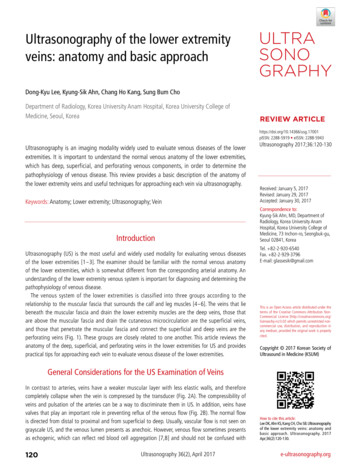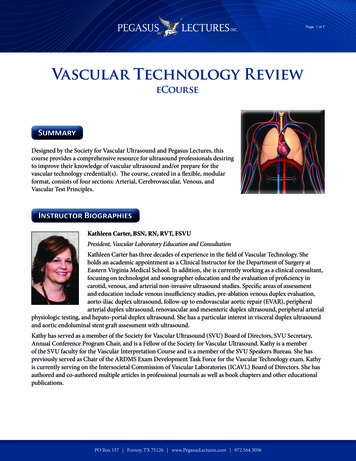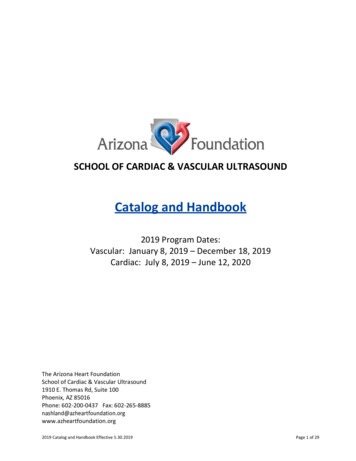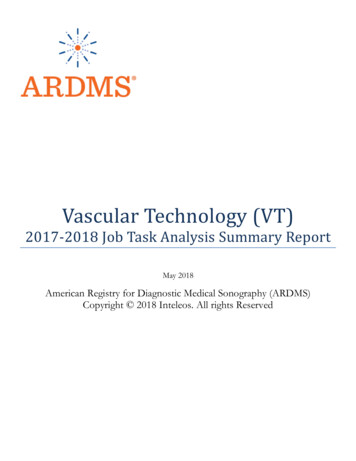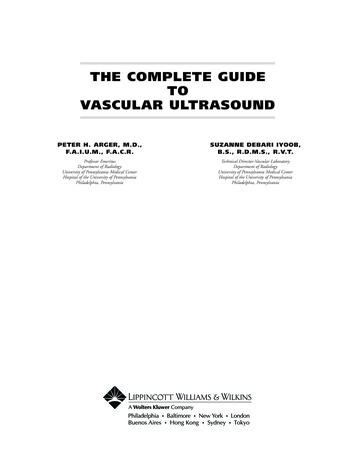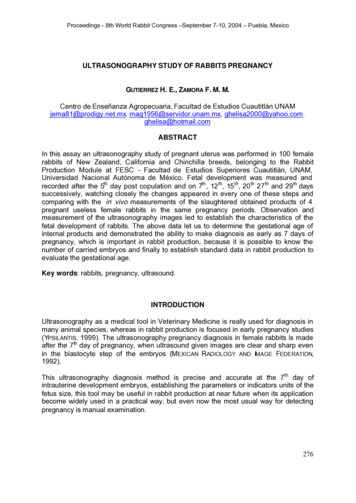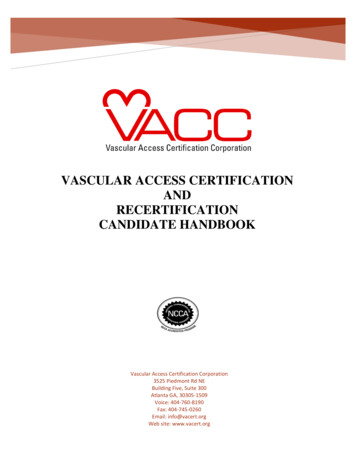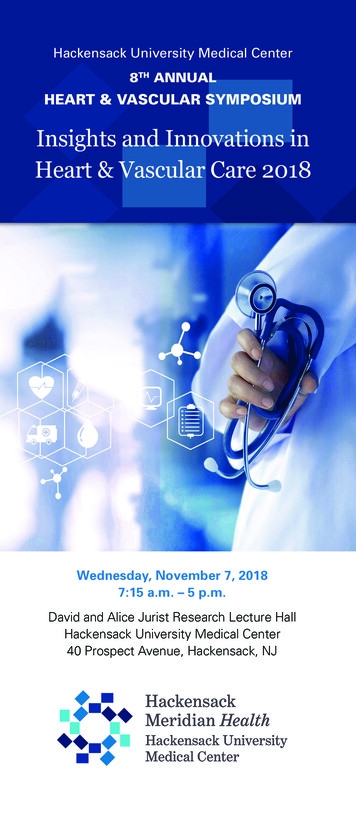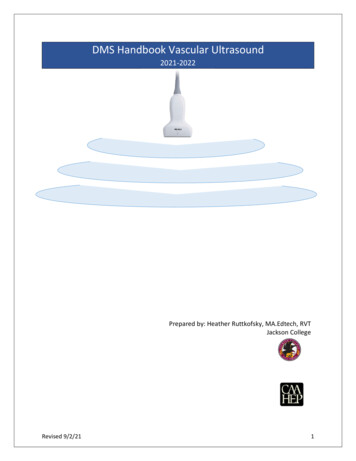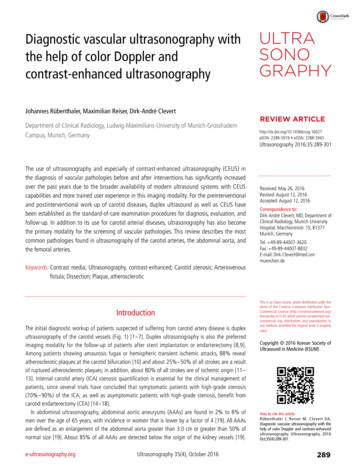
Transcription
Diagnostic vascular ultrasonography withthe help of color Doppler andcontrast-enhanced ultrasonographyJohannes Rübenthaler, Maximilian Reiser, Dirk-André ClevertDepartment of Clinical Radiology, Ludwig-Maximilians-University of Munich-GrosshadernCampus, Munich, GermanyREVIEW ARTICLEhttp://dx.doi.org/10.14366/usg.16027pISSN: 2288-5919 eISSN: 2288-5943Ultrasonography 2016;35:289-301The use of ultrasonography and especially of contrast-enhanced ultrasonography (CEUS) inthe diagnosis of vascular pathologies before and after interventions has significantly increasedover the past years due to the broader availability of modern ultrasound systems with CEUScapabilities and more trained user experience in this imaging modality. For the preinterventionaland postinterventional work-up of carotid diseases, duplex ultrasound as well as CEUS havebeen established as the standard-of-care examination procedures for diagnosis, evaluation, andfollow-up. In addition to its use for carotid arterial diseases, ultrasonography has also becomethe primary modality for the screening of vascular pathologies. This review describes the mostcommon pathologies found in ultrasonography of the carotid arteries, the abdominal aorta, andthe femoral arteries.Received: May 26, 2016Revised: August 12, 2016Accepted: August 12, 2016Correspondence to:Dirk-André Clevert, MD, Department ofClinical Radiology, Munich UniversityHospital, Marchioninistr. 15, 81377Munich, GermanyTel. 49-89-44007-3620Fax. 49-89-44007-8832E-mail: Dirk.Clevert@med.unimuenchen.deKeywords: Contrast media; Ultrasonography, contrast-enhanced; Carotid stenosis; Arteriovenousfistula; Dissection; Plaque, atheroscleroticIntroductionThe initial diagnostic workup of patients suspected of suffering from carotid artery disease is duplexultrasonography of the carotid vessels (Fig. 1) [1-7]. Duplex ultrasonography is also the preferredimaging modality for the follow-up of patients after stent implantation or endarterectomy [8,9].Among patients showing amaurosis fugax or hemispheric transient ischemic attacks, 88% revealatherosclerotic plaques at the carotid bifurcation [10] and about 25%-50% of all strokes are a resultof ruptured atherosclerotic plaques; in addition, about 80% of all strokes are of ischemic origin [1113]. Internal carotid artery (ICA) stenosis quantification is essential for the clinical management ofpatients, since several trials have concluded that symptomatic patients with high-grade stenosis(70%-90%) of the ICA, as well as asymptomatic patients with high-grade stenosis, benefit fromcarotid endarterectomy (CEA) [14-18].In abdominal ultrasonography, abdominal aortic aneurysms (AAAs) are found in 2% to 8% ofmen over the age of 65 years, with incidence in women that is lower by a factor of 4 [19]. All AAAsare defined as an enlargement of the abdominal aorta greater than 3.0 cm or greater than 50% ofnormal size [19]. About 85% of all AAAs are detected below the origin of the kidney vessels [19].e-ultrasonography.orgUltrasonography 35(4), October 2016This is an Open Access article distributed under theterms of the Creative Commons Attribution NonCommercial License (http://creativecommons.org/licenses/by-nc/3.0/) which permits unrestricted noncommercial use, distribution, and reproduction inany medium, provided the original work is properlycited.Copyright 2016 Korean Society ofUltrasound in Medicine (KSUM)How to cite this article:Rübenthaler J, Reiser M, Clevert DA.Diagnostic vascular ultrasonography with thehelp of color Doppler and contrast-enhancedultrasonography. Ultrasonography. 2016Oct;35(4):289-301.289
Johannes Rübenthaler, et al.BCAFig. 1. Ultrasonography of a carotid bulb.A, B. B-Scan (A) and color Doppler (B) sonograms of the carotid bulb demonstrate the distal common carotid artery (asterisk), the proximalinternal carotid artery (ICA) (arrow) and external carotid artery (ECA) (arrowhead). C. Contrast-enhanced ultrasonography of the carotid bulbdemonstrates the perfused lumen of distal common carotid artery, the proximal ICA and ECA.Surgical intervention is recommended at any diameter greaterthan 5.5 cm in men or 5.0 cm in women [19]. The main risk is arupture, with a risk of less than 1% for aneurysms with a size ofless than 5.5 cm, 10% for aneurysms with a diameter between 5.5cm and 7.0 cm, and 33% for aneurysms larger than 7.0 cm [19]. Aruptured AAA shows a mortality rate of 85% to 90% [19]. Clinicalmanagement includes conservative treatment with follow-upultrasonography for asymptomatic AAAs with a diameter less than5.5 cm, as there is a higher risk of peri-interventional complicationsthan of rupture and surgical repair for AAAs above that size, withcontrast-enhanced ultrasonography (CEUS) follow-up examinationsafter endovascular aneurysm repair (EVAR) [20-28].Duplex ultrasonography is also the imaging modality of choicefor the detection of complications after puncture of the femoralartery, as they occur in 0.1%-9% of cases with aneurysms, witharteriovenous fistulas, dissections, and hematomas being the mostcommon complications [29-34].reflect an echo with an amplified echo intensity of up to 30 dB[35,37]. Major side effects must be taken into consideration, whichare comparable to those of contrast agents used for other imagingmodalities. The most important possible side effect of an ultrasoundcontrast agent is an anaphylactic reaction, which is described tooccur in one out of 10,000 cases [38,39].SonoVue (Bracco, Milan, Italy), most commonly used amongmodern ultrasonography contrast agents, consists of phospholipidshells, which stabilize microbubbles, and their core, containingsulphur hexafluoride (SF6) gas. Once administered, the ultrasoundcontrast agent is quickly eliminated. The phospholipids aremetabolized endogenously and the SF6 gas is exhaled via thelungs within a time period of up to 8 minutes. At 2-10 µm, asingle microbubble is about the size of an average erythrocyte. Fordiagnostic views of the vessels, 1.6 to 2.4 mL of contrast agentshould be intravenously administered as a bolus injection, followedby a flush of 5-10 mL of saline solution (0.9% NaCl) in order toachieve good contrast [40].Contrast-Enhanced Ultrasonography TechniqueWith the implementation of specific contrast modes in modernultrasound systems and the broader availability of these systems inthe clinical routine, CEUS can be used for the assessment of vascularcomplications. Modern contrast modes use a low mechanicalindex mode that processes the non-linear signals emitted by themicrobubbles of the contrast agent and separates out the signalsof the tissue and the contrast agent [35,36]. The contrast agent isintravenously administered through a needle of at least 18G. Themicrobubbles oscillate in response to the emitted ultrasound and290Carotid Arterial DiseasesStenosisAbout 10%-15% of all strokes and transitory attacks of ischemicorigin are the consequence of an atherosclerotic stenosis of theICA, especially of the proximal part [41]. Most important in theinitial workup of ICA stenosis is the differentiation betweena total occlusion of the ICA or a preocclusive stenosis that ischaracterized as a stenosis of at least 90% [42-47]. Preocclusivesymptomatic stenosis can be treated with surgical intervention orUltrasonography 35(4), October 2016e-ultrasonography.org
CEUS in vascular diseaseswith other interventional measures in order to prevent a threateninghemiparesis [3,6]. With sensitivities between 86% and 98% andspecificities between 87% and 100%, vascular ultrasonography ofthe ICA has a high diagnostic accuracy in the characterization ofICA stenosis and in the differentiation of ICA occlusions, dependenton examiner experience and parameter settings [48-50]. WithCEUS, it is even possible to advance the visualization of carotidartery diseases by detecting the blood flow through the stenosiseven in elongated vessels, without the disadvantage of an angledependency or aliasing or blooming flow artifacts (Fig. 2) [51-55].Postinterventional Follow-upCarotid artery stenting (CAS) is an alternative to the traditionalCEA, especially in patients with a high risk of complicationsfrom undergoing surgery, for example, patients with significantcardiopulmonary disease [57-59]. The use of CEA carries a risk ofrestenosis of about 25%, whereas the risk of restenosis after CAS isbelow 5% in most cases in the initial 5 years after stenting [9,6063]. Duplex ultrasonography and CEUS are the imaging modalitiesof choice for postinterventional surveillance for restenosis after CASand for the characterization of in-stent restenosis after stenting,with CEUS providing a reduction of flow artifacts and a bettervisualization of the morphology of the restenosis compared to colorand power Doppler (Fig. 3) [64-66].The traditional method of choice for the treatment of symptomaticand asymptomatic patients with ICA stenosis is the CEA [47,56].ABDCFig. 2. Ultrasonography of a 67-year-old woman with recent ischemic neurological symptoms.A. B-Scan shows a high-degree internal carotid artery (ICA) stenosis with soft plaques (arrow). B, C. Duplex ultrasonography shows a highdegree stenosis of the ICA (arrowhead) with a maximal systolic flow velocity of about 500 cm/sec. D. Contrast-enhanced ultrasonography(CEUS) detects the intrastenotic flow (arrowhead) without overwriting the wall of the vessel and reveals the complete residual lumen andthe length of the stenosis. Additionally, CEUS confirms the absence of intraplaque neovascularization (arrow).e-ultrasonography.orgUltrasonography 35(4), October 2016291
Johannes Rübenthaler, et al.DissectionComplications after InterventionCervical dissections are rather uncommon and can be divided intospontaneous or traumatic dissections. The annual incidence ofdissections is about 1-3 out of 100,000 cases, and they account for15%-20% of all cerebral infarctions in adolescents [67]. Clinicalsymptoms of dissections vary acutely from individual to individual[68]. Vascular ultrasonography is the imaging modality of choice forthe detection and characterization of acute dissection by imagingthe mural hematoma as well as the false and true lumen, alongwith the normal visualization of a decreased blood volume flowin the false lumen that results in an increased risk for thrombosis,embolization, or even partial or total occlusion of the artery [69-71].Modern ultrasound probes can even identify a small dissection withvery thin membranes of less than 1 mm [4,72,73]. The use of CEUScan aid diagnosis and improve diagnostic accuracy in difficult cases[51,53].With an incidence of about 2%-10%, the puncture of the carotidartery is the most common complication after central venouscatheterization of the internal jugular vein [74,75]. This interventionis mostly performed at the intensive care unit or for interventionalradiological procedures. The most important complication isan arteriovenous fistula that can occasionally be seen clinicallyas a swelling of the neck, sometimes pulsatile [76]. Duplexultrasonography and CEUS are the imaging modalities of choice forthe detection of arteriovenous fistulae, with CEUS being the superiorimaging technique because of its independence from aliasing oroverwriting artifacts (Fig. 4) [5,77,78].APlaque CharacterizationUlcerating plaques are thought to be a factor in the aetiology ofstrokes from carotid arterial diseases [79,80]. The use of CEUS is animaging modality option for detecting plaque ulceration that mightBDCFig. 3. Longitudinal ultrasonography after internal carotid artery (ICA) stent insertion.A. B-Scan shows an ICA stent (arrowheads). B. Power Doppler ultrasonography could not depict any in-stent stenosis. C. Cross-sectionalcontrast-enhanced ultrasonography (CEUS) image of the ICA stent shows the semi-circular soft plaque (arrow) and the remaining perfusedlumen of the ICA stent. According to the criteria of an area stenosis, the degree of the in-stent stenosis will be about 40%-50%. D. CEUSshows some soft plaques (arrow) at the anterior ICA stent wall.292Ultrasonography 35(4), October 2016e-ultrasonography.org
CEUS in vascular diseasesbe caused by inflammatory processes and neovascularization insidethe plaque; it assesses the contrast uptake in plaques via time-signalintensity curves (Fig. 5) [52,81-84].Abdominal Aortic AneurysmAbdominal Aortic AneurysmAAAs are defined as an enlargement of the abdominal aorta greaterthan 3.0 cm or greater than 50% of normal size [19]. A rupturedAAA shows a mortality rate of 85% to 90% and is the 10thmost common cause of death in men over the age of 55 [19,20].Immediate treatment of a ruptured AAA is essential, as an untreatedruptured AAA is most likely to result in death [20]. About 85% ofall AAAs are detected below the origin of the kidney vessels [19].ASurgical intervention is recommended at any diameter greater than5.5 cm in men or 5.0 cm in women [19]. The main risk is a rupture,with a risk of less than 1% for aneurysms with a diameter of lessthan 5.5 cm, 10% for aneurysms with a diameter between 5.5 and7.0 cm and 33% for aneurysms with a diameter greater than 7.0 cm[19]. With a sensitivity of 95%-98%, duplex ultrasonography is theinitial imaging method of choice for the diagnosis of AAAs [85]. Theuse of CEUS can help visualize the direct signs of a rupture (Fig. 6)[86].Postinterventional Follow-upAfter EVAR of an AAA, the stent needs lifelong imaging surveillancein order to detect complications like endoleaks, fractures, or aprogressive enlargement of the AAA [27]. After EVAR, CEUS is theBDCFig. 4. Ultrasonography after central line placement.A. Cross-sectional B-scan identifies a hypo-echoic structure suggesting hematoma (arrowheads) without communication between thecommon carotid artery (asterisk) and the internal jugular vein (arrow). B. The hematoma does not show any perfusion (arrowhead) oncolor Doppler sonogram. C, D. Contrast-enhanced sonograms of the common carotid artery demonstrate the uptake of contrast inside thehematoma (arrowheads) as the presence of a pseudo-aneurysm after central line placement without aliasing or any overwriting artifacts.e-ultrasonography.orgUltrasonography 35(4), October 2016293
Johannes Rübenthaler, et al.ABFig. 5. Ultrasonography of an atheromatous plaque in the carotid artery.A. B-Scan of show a significant stenosis by atheromatous plaques (arrows). B. Contrast-enhanced ultrasonography shows aneovascularization inside the plaque (arrowhead) as a sign of plaque vulnerability.ABFig. 6. Ultrasonography of an infrarenal aortic aneurysm.A, B. B-Scan (A) and color Doppler (B) sonograms demonstrateinfra-aortic aneurysm (arrows). C. Real time-resolved 4D contrastenhanced ultrasonography shows the same infrarenal aorticaneurysm in the x-plane (right top), y-plane (right middle), andz-plane (right bottom) with a volume image (left).C294Ultrasonography 35(4), October 2016e-ultrasonography.org
CEUS in vascular diseasesimaging modality of choice, as it allows a fast and noninvasivediagnosis during follow-up. The sensitivity and specificity for thedetection of endoleaks is 98%-100% and 82%-93%, respectively(Fig. 7) [21].Vascular Complications after TransfemoralPuncturePseudoaneurysmsas a rupture in the layer of the wall of an artery that does notocclude after puncture. The leaking blood causes a pulsatilehematoma that forms a blood-filled cavity that is fed through aconnection between the cavity and the punctured artery. Withincreasing size there is an increased risk for rupture, making a rapiddiagnosis essential [90]. Duplex ultrasonography and CEUS are theimaging modalities of choice for the detection of pseudoaneurysms,with CEUS being the preferred imaging technique because it isindependent of aliasing or overwriting artifacts (Fig. 8) [91].False aneurysms or pseudoaneurysms after transfemoral punctureoccur in 0.05%-9% of all cases [29,87-89]. They are characterizedBCAFig. 7. Ultrasonography of the abdominal aortic aneurysm after endovascular aneurysm repair.A, B. Cross-sectional B-scan (A) and color Doppler (B) sonograms show aortic aneurysm (crosshairs) with right and left stent graft legs (arrows).No endoleak was detected. C. Contrast-enhanced ultrasonography shows a type II endoleak (arrowheads) over the left lumbar artery.BCAFig. 8. Ultrasonography of the femoral artery after catheter intervention.A, B. Cross-sectional B-scan (A) and color Doppler (B) sonograms of femoral artery (asterisks) delineate a pseudoaneurysm (arrowheads)without any discernable flow signal. C. Contrast-enhanced ultrasonography shows a partial perfusion (arrow) of pseudoaneurysm, while thedistal part does not show any perfusion (arrowheads).e-ultrasonography.orgUltrasonography 35(4), October 2016295
Johannes Rübenthaler, et al.Arteriovenous FistulaArteriovenous fistulae occur in 0.1%-3.6% of all cases aftertransfemoral puncture [29,34,88]. They are described asiatrogenically abnormally connected arteries and veins. If the fistulais large enough, they can be hemodynamically relevant, causinga decrease in peripheral resistance [92]. Arteriovenous fistulaeshow a tendency to increase in size, making surgical treatmentthe intervention of choice in many cases. In some cases, thearteriovenous fistula occludes spontaneously or can be compressedvia ultrasonography [76]. Duplex ultrasonography and CEUS arethe imaging modalities of choice for the detection of arteriovenousfistulae, with CEUS being the superior imaging technique becauseof its independence from aliasing or overwriting artifacts (Fig. 9)[5,77,78].BCAFig. 9. Ultrasonography of the femoral artery after catheter intervention.A, B. On cross-sectional B-scan (A) and color Doppler (B) sonograms, arteriovenous fistula with turbulent blood flow in the arteriovenousfistula track (arrowheads) is depicted between the common femoral artery (arrow) and vein (asterisk). The complete extent of the fistuloustrack is due to aliasing demarcated. C. Contrast-enhanced ultrasonography of the common femoral artery and vein identified the completeextent of the arteriovenous fistulous track (arrowheads) and confirmed the presence of an arteriovenous communication without aliasingor any overwriting artifacts. The distal part of the common femoral vein (asterisk) does not show any contrast uptake due to the arterialscanning.BCAFig. 10. Ultrasonography of common femoral artery dissection.A, B. B-Scan (A) and color Doppler (B) sonograms show the common femoral artery with intimal dissection (arrowheads). Both lumens areperfused in the color Doppler setting (arrows). C. Due to its superior spatial resolution, the dissection membrane (arrowheads) and bothperfused lumens are clearly depicted on contrast-enhanced ultrasonography.296Ultrasonography 35(4), October 2016e-ultrasonography.org
CEUS in vascular diseasesDissectionDissections occur in 0.3%-3.6% of all cases after transfemoralpuncture [66,93]. Similarly as was described before for thedissection of the carotid arteries, vascular ultrasonography is theimaging modality of choice for the detection and characterizationof dissection, by showing the mural hematoma as well as the falseand true lumen, and by additionally visualizing any decreased bloodvolume flow in the false lumen that results in an increased risk forthrombosis, embolization, or even partial or total occlusion of theartery [69-71]. As discussed before, modern ultrasound probescan identify small dissection with very thin membranes of less than1 mm [4,72,73]. CEUS can help aid diagnosis and improves thediagnostic accuracy in difficult cases (Figs. 10, 11) [51,53].HematomaHematomas occur in 0.4%-11% of all cases after transfemoralApuncture [29,66,94] and are a rather common complication in thiscircumstance. Normally, hematomas are locally limited and areresorbed within a short period of time. They can be easily depictedusing duplex ultrasonography.ConclusionFor the detection, characterization, and follow-up of vascularpathologies, duplex ultrasonography is the first choice. However,duplex ultrasonography has technical limitations in diagnostic use,for example, due to aliasing artifacts that can complicate diagnosis.The use of CEUS can increase the diagnostic performance indifficult vascular disorders compared to duplex ultrasonography.Thus, CEUS has become a promising, safe, noninvasive imagingtool in different aortic pathologies, particularly for the detection ofendoleaks following endovascular treatment of AAAs. ExaminationsBDCFig. 11. Ultrasonography of the common femoral artery with suspicious dissection.A, B. B-Scan (A) and color Doppler (B) sonograms show incomplete perfusion of the vessel lumen (arrows). C, D. Longitudinal (C) and crosssectional (D) contrast-enhanced images demonstrate a floating embolus (arrowheads) in the center of the common femoral artery (arrow).Due to its superior spatial resolution, contrast-enhanced ultrasonography could be used to exclude the possibility of arterial dissection.e-ultrasonography.orgUltrasonography 35(4), October 2016297
Johannes Rübenthaler, et al.using CEUS of the carotid artery and peripheral vessels improvethe delineation of vascular disorders in selected cases. It is afast, nonionizing, cost effective imaging modality with almostno contraindications. The use of an ultrasound contrast agentincreases the sensitivity of ultrasonography in vascular diseases andovercomes some limitations in the detection of blood flow withinvascular structures. With the broader availability of contrast modesin modern ultrasound systems and the ongoing distribution of thesesystems to sonographers, CEUS is an already established, but stillemerging imaging technique with a promising future.ORCID: Johannes Rübenthaler: http://orcid.org/0000-0003-0832-5662; MaximilianReiser: http://orcid.org/0000-0003-1098-8190; Dirk-André Clevert: http://orcid.org/0000-0003-3889-5447Conflict of InterestNo potential conflict of interest relevant to this article was reported.References1. Rubenthaler J, Lutz J, Reiser M, Clevert DA. Title page:paraganglioma of the head and neck: follow-up of interventionalprocedures with CEUS. Ultraschall Med 2015;36:541-543.2. Clevert DA, Johnson T, Michaely H, Jung EM, Flach PM, Strautz TI,et al. High-grade stenoses of the internal carotid artery: comparisonof high-resolution contrast enhanced 3D MRA, duplex sonographyand power Doppler imaging. Eur J Radiol 2006;60:379-386.3. Clevert DA, Johnson T, Jung EM, Clevert DA, Flach PM, StrautzTI, et al. Color Doppler, power Doppler and B-flow ultrasoundin the assessment of ICA stenosis: comparison with 64-MD-CTangiography. Eur Radiol 2007;17:2149-2159.4. Clevert DA, Rupp N, Reiser M, Jung EM. Improved diagnosis ofvascular dissection by ultrasound B-flow: a comparison withcolor-coded Doppler and power Doppler sonography. Eur Radiol2005;15:342-347.5. Clevert DA, Kubisch C, Weckbach S, Frey U, Stock K, Reiser M.B-flow and color Doppler sonography findings in iatrogenic carotidjugular arteriovenous fistula. Clin Hemorheol Microcirc 2010;44:1925.6. Jung EM, Kubale R, Ritter G, Gallegos MT, Jungius KP, Rupp N, etal. Diagnostics and characterisation of preocclusive stenoses andocclusions of the internal carotid artery with B-flow. Eur Radiol2007;17:439-447.7. Jungius KP, Jung EM, Clevert DA. High-grade stenosis of theinternal carotid artery: ultrasonographic characterization. Praxis(Bern 1994) 2006;95:801-808.8. Schulte-Altedorneburg G, Clevert DA. Color duplex sonography ofextracranial brain-supplying arteries. Radiologe 2009;49:10161023.2989. Gurm HS, Yadav JS, Fayad P, Katzen BT, Mishkel GJ, Bajwa TK, etal. Long-term results of carotid stenting versus endarterectomy inhigh-risk patients. N Engl J Med 2008;358:1572-1579.10. Eisenberg RL, Nemzek WR, Moore WS, Mani RL. Relationship oftransient ischemic attacks and angiographically demonstrablelesions of carotid artery. Stroke 1977;8:483-486.11. Adams HP Jr, Bendixen BH, Kappelle LJ, Biller J, Love BB, GordonDL, et al. Classification of subtype of acute ischemic stroke:definitions for use in a multicenter clinical trial. TOAST. Trial of Org10172 in Acute Stroke Treatment. Stroke 1993;24:35-41.12. Meerwaldt R, Hermus L, Reijnen MM, Zeebregts CJ. Carotidendarterectomy: current consensus and controversies. Surg TechnolInt 2010;20:283-291.13. Hermus L, van Dam GM, Zeebregts CJ. Advanced carotid plaqueimaging. Eur J Vasc Endovasc Surg 2010;39:125-133.14. Krinsky G. Gadolinium-enhanced three-dimensional magneticresonance angiography of the thoracic aorta and arch vessels: areview. Invest Radiol 1998;33:587-605.15. Krinsky G, Rofsky NM. MR angiography of the aortic archvessels and upper extremities. Magn Reson Imaging Clin N Am1998;6:269-292.16. Saloner D. Determinants of image appearance in contrastenhanced magnetic resonance angiography: a review. Invest Radiol1998;33:488-495.17. Endarterectomy for asymptomatic carotid artery stenosis. ExecutiveCommittee for the Asymptomatic Carotid Atherosclerosis Study.JAMA 1995;273:1421-1428.18. Moore WS, Barnett HJ, Beebe HG, Bernstein EF, Brener BJ, BrottT, et al. Guidelines for carotid endarterectomy: a multidisciplinaryconsensus statement from the Ad Hoc Committee, American HeartAssociation. Circulation 1995;91:566-579.19. Kent KC. Clinical practice: abdominal aortic aneurysms. N Engl JMed 2014;371:2101-2108.20. Clevert DA, Horng A, Reiser MF. Ultrasound imaging of theabdominal aorta. Radiologe 2009;49:1024-1032.21. Clevert DA, Horng A, Kopp R, Schick K, Meimarakis G, Sommer WH,et al. Imaging of endoleaks after endovascular aneurysm repair(EVAR) with contrast-enhanced ultrasound (CEUS). Radiologe2009;49:1033-1039.22. Clevert DA, Horng A, Clevert DA, Jung EM, Sommer WH, ReiserM. Contrast-enhanced ultrasound versus conventional ultrasoundand MS-CT in the diagnosis of abdominal aortic dissection. ClinHemorheol Microcirc 2009;43:129-139.23. Clevert DA, Helck A, D'Anastasi M, Gurtler V, Sommer WH,Meimarakis G, et al. Improving the follow up after EVAR by usingultrasound image fusion of CEUS and MS-CT. Clin HemorheolMicrocirc 2011;49:91-104.24. Clevert DA, Gurtler VM, Meimarakis G, D'Anastasi M, WeidenhagenR, Reiser MF, et al. Classification of endoleaks in the follow-upUltrasonography 35(4), October 2016e-ultrasonography.org
CEUS in vascular 39.40.41.after EVAR using the time-to-peak of the contrast agent in CEUSexaminations. Clin Hemorheol Microcirc 2013;55:183-191.Filardo G, Powell JT, Martinez MA, Ballard DJ. Surgery for smallasymptomatic abdominal aortic aneurysms. Cochrane DatabaseSyst Rev 2015;(2):CD001835.Powell JT, Brown LC, Forbes JF, Fowkes FG, Greenhalgh RM, RuckleyCV, et al. Final 12-year follow-up of surgery versus surveillance inthe UK Small Aneurysm Trial. Br J Surg 2007;94:702-708.Cantisani V, Grazhdani H, Clevert DA, Iezzi R, Aiani L, Martegani A,et al. EVAR: benefits of CEUS for monitoring stent-graft status. EurJ Radiol 2015;84:1658-1665.Cantisani V, David E, Mauro L, D'Ambrosio F, Clevert DA. CEUS:what is its role in abdominal aortic diseases? Med Ultrason2015;17:419-421.Chandrasekar B, Doucet S, Bilodeau L, Crepeau J, deGuise P,Gregoire J, et al. Complications of cardiac catheterization in thecurrent era: a single-center experience. Catheter Cardiovasc Interv2001;52:289-295.Heintzen MP, Strauer BE. Peripheral arterial complications afterheart catheterization. Herz 1998;23:4-20.Neise M, Ranke C, Laschewski F, Trappe HJ. Pseudoaneurysm withassociated arteriovenous fistula after transfemoral puncture. MedKlin (Munich) 1998;93:107-110.Righini M, Quere I, Laroche JP. Treatment of postcatheterizationfemoral false aneurysms. J Mal Vasc 2004;29:63-72.Thalhammer C, Kirchherr AS, Uhlich F, Waigand J, Gross CM.Postcatheterization pseudoaneurysms and arteriovenous fistulas:repair with percutaneous implantation of endovascular coveredstents. Radiology 2000;214:127-131.Perings SM, Kelm M, Jax T, Strauer BE. A prospective study onincidence and risk factors of arteriovenous fistulae followingtransfemoral cardiac catheterization. Int J Cardiol 2003;88:223228.Greis C. Ultrasound contrast agents as markers of vascularity andmicrocirculation. Clin Hemorheol Microcirc 2009;43:1-9.Greis C. Summary of technical principles of contrast sonographyand future perspectives. Radiologe 2011;51:456-461.Horng A, Reiser M, Clevert DA. Current developments in vascularultrasound. Radiologe 2009;49:998-1004.Piscaglia F, Bolondi L; Italian Society for Ultrasound in Medicine andBiology (SIUMB) Study Group on Ultrasound Contrast Agents. Thesafety of Sonovue in abdominal applications: retrospective analysisof 23188 investigations. Ultrasound Med Biol 2006;32:1369-1375.ter Haar G. Safety and bio-effects of ultrasound contrast agents.Med Biol Eng Comput 2009;47:893-900.Ravine D, Gibson RN, Donlan J, Sheffield LJ. An ultrasound renalcyst prevalence survey: specificity data for inherited renal cysticdiseases. Am J Kidney Dis 1993;22:803-807.Fine-Edelstein JS, Wolf PA, O'Leary DH, Poehlman H, Belanger .51.52.53.54.55.Kase CS, et al. Precursors of extracranial carotid atherosclerosis inthe Framingham Study. Neurology 1994;44:1046-1050.Borisch I, Horn M, Butz B, Zorger N, Draganski B, Hoelscher T, etal. Preoperative evaluation of carotid artery stenosis: comparisonof contrast-enhanced MR angiography and duplex sonographywith digital subtraction angiography. AJNR Am J Neuroradiol2003;24:1117-1122.Polak JF. Carotid ultrasound. Radiol Clin North Am 2001;39:569589.Lee W. General principles of carotid Doppler ultrasonography.Ultrasonography 2014;33:11-17.Schminke U, Motsch L, Griewing B, Gaull M, Kessler C. Threedimensional power-mode ultrasound for quantification ofthe progression of carotid artery atherosclerosis. J Neurol2000;247:106-111.Hetzel A, Eckenweber B, Trummer B, Wernz M, Schumacher M, vonReutern G. Colour-coded duplex sonography of preocclusive carotidstenoses. Eur J Ultrasound 1998;8:183-191.North Ameri
Vascular ultrasonography is the imaging modality of choice for . Modern ultrasound probes can even identify a small dissection with very thin membranes of less than 1 mm [4,72,73]. The use of CEUS can aid diagnosis an
